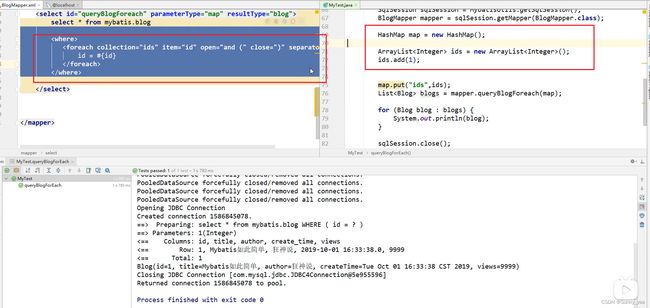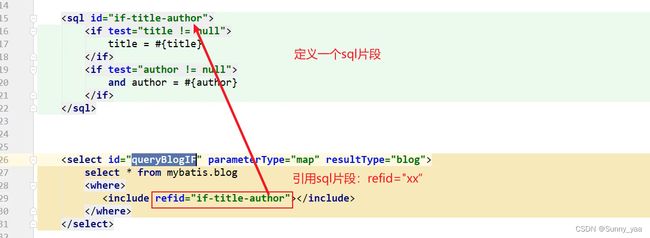Mybatis之动态SQL
动态SQL标签
- IF标签 choose、
- when标签
- otherwise标签
- where标签
- set标签
- foreach标签
SQL片段
动态 SQL 是 MyBatis 的强大特性之一。如果你使用过 JDBC 或其它类似的框架,你应该能理解根据不同条件拼接 SQL 语句有多痛苦,例如拼接时要确保不能忘记添加必要的空格,还要注意去掉列表最后一个列名的逗号。利用动态 SQL,可以彻底摆脱这种痛苦。
IF标签
使用动态 SQL 最常见情景是根据条件包含 where 子句的一部分。比如:
<if test="title != null"> </if> test为表达式
SELECT * FROM BLOG WHERE state = ‘ACTIVE’ 如果if里的title != null 那么久追加一句SQL语句:title like #{title}
变成: SELECT * FROM BLOG WHERE state = ‘ACTIVE’ AND title like #{title}
<select id="findActiveBlogWithTitleLike" resultType="Blog">
SELECT * FROM BLOG
WHERE state = ‘ACTIVE’
<if test="title != null">
AND title like #{title}
</if>
</select>
choose、when、otherwise标签
有时候,我们不想使用所有的条件,而只是想从多个条件中选择一个使用。但是如果写成上面的那么多个IF标签不太合理。针对这种情况,MyBatis 提供了 choose 元素,它有点像 Java 中的 switch 语句。
还是上面的例子,但是策略变为:传入了 “title” 就按 “title” 查找,传入了 “author” 就按 “author” 查找的情形。
若两者都没有传入,就拼接标记的 SQL。
<select id="findActiveBlogLike"
resultType="Blog">
SELECT * FROM BLOG WHERE state = ‘ACTIVE’
<choose>
<when test="title != null">
AND title like #{title}
</when>
<when test="author != null and author.name != null">
AND author_name like #{author.name}
</when>
<otherwise>
AND featured = 1
</otherwise>
</choose>
</select>
但是where语句有个弊端,如果where后面直接跟或者但是条件都没有满足的话会出现where后面直接跟and的错误,例如下面:

<select id="findActiveBlogLike"
resultType="Blog">
SELECT * FROM BLOG WHERE //后面直接跟if标签了没有了在一个条件缓冲
<if test="state != null">
state = #{state}
</if>
<if test="title != null">
AND title like #{title}
</if>
<if test="author != null and author.name != null">
AND author_name like #{author.name}
</if>
</select>
结果成这样:
SELECT * FROM BLOG WHERE AND title like ‘someTitle’
where标签
为了解决上述问题,进行小小变动,把where写成一个标签
并且where 元素只会在子元素返回任何内容的情况下才插入 “WHERE” 子句。而且,若子句的开头为 “AND” 或 “OR”,where 元素也会将它们去除。
<select id="findActiveBlogLike"
resultType="Blog">
SELECT * FROM BLOG
<where>
<if test="state != null">
state = #{state}
</if>
<if test="title != null">
AND title like #{title}
</if>
<if test="author != null and author.name != null">
AND author_name like #{author.name}
</if>
</where>
</select>
set标签
set 元素会动态地在行首插入 SET 关键字,并会删掉额外的逗号(这些逗号是在使用条件语句给列赋值时引入的)
<update id="updateAuthorIfNecessary">
update Author
<set>
<if test="username != null">username=#{username},</if>
<if test="password != null">password=#{password},</if>
<if test="email != null">email=#{email},</if>
<if test="bio != null">bio=#{bio}</if>
</set>
where id=#{id}
</update>
foreach标签
动态 SQL 的另一个常见使用场景是对集合进行遍历(尤其是在构建 IN 条件语句的时候)。比如:
集合项(item)和索引(index)变量以及返回对象类型collection
<select id="selectPostIn" resultType="domain.blog.Post">
SELECT *
FROM POST P
WHERE ID in
<foreach item="item" index="index" collection="list"
open="(" separator="," close=")">
#{item}
</foreach>
</select>
SQL片段
用于一些代码总是复写时,可以抽取出来成为公共的,用时直接使用include标签引用


